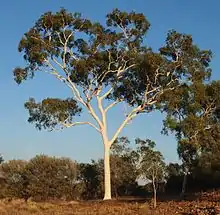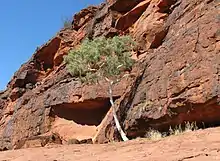Corymbia aparrerinja
Corymbia aparrerinja, commonly known as ghost gum,[2] is a species of tree that is endemic to Central Australia. It has smooth bark, lance-shaped or curved adult leaves, flower buds in groups of three or seven, white flowers and cup-shaped to cylindrical fruit.
| Corymbia aparrerinja | |
|---|---|
 | |
| Ghost gums in Central Australia. | |
| Scientific classification | |
| Kingdom: | Plantae |
| Clade: | Tracheophytes |
| Clade: | Angiosperms |
| Clade: | Eudicots |
| Clade: | Rosids |
| Order: | Myrtales |
| Family: | Myrtaceae |
| Genus: | Corymbia |
| Species: | C. aparrerinja |
| Binomial name | |
| Corymbia aparrerinja | |
| Synonyms[1] | |
| |

Description
Corymbia aparrerinja is a tree that typically grows to a height of 20 m (66 ft), often much less, and forms a lignotuber. It has smooth, sometimes powdery, white to cream-coloured and pinkish bark that is shed in thin patches. Young plants and coppice regrowth have egg-shaped leaves that are 50–155 mm (2.0–6.1 in) long, 20–65 mm (0.79–2.56 in) wide and arranged in opposite pairs. Adult leaves are arranged alternately, the same shade of glossy green on both sides, lance-shaped or curved, 50–165 mm (2.0–6.5 in) long and 7–32 mm (0.28–1.26 in) wide tapering to a petiole 5–20 mm (0.20–0.79 in) long. The flower buds are arranged on the ends of branchlets on a branched peduncle 5–38 mm (0.20–1.50 in) long, each branch with groups of three or seven buds, the individual buds on pedicels 2–5 mm (0.079–0.197 in) long. Mature buds are oval to pear-shaped, 6–7 mm (0.24–0.28 in) long and 5–6 mm (0.20–0.24 in) wide with a rounded operculum. Flowering occurs in summer and the flowers are white. The fruit is a woody cup-shaped to more or less cylindrical capsule 9–13 mm (0.35–0.51 in) long and 7–9 mm (0.28–0.35 in) wide with the valves near rim level or enclosed.[2][3]
Taxonomy and naming
Corymbia aparrerinja was first formally described in 1995 by Ken Hill and Lawrie Johnson from specimens collected on Gosses Bluff by Herbert Basedow in 1925.[4] The same specimens were used by William Blakely to describe (in English), Eucalyptus papuana F.Muell. var. aparrerinja, but did not provide a Latin diagnosis ("description"), so the name was not validly published.[3][5]
Distribution and habitat
Ghost gum occurs in arid areas of Central Australia on rocky slopes, red sand flats and dry creek beds. It is found from near Giles in Western Australia, through the south of the Northern Territory as far north as Tennant Creek to near Mount Isa and Barcaldine in Queensland.[2][6]
Uses
Parts of this tree were used by Indigenous Australians to treat colds.[7]
Culture
In 1891 in Barcaldine, a ghost gum known as the Tree of Knowledge, was the focal point of a gathering of striking sheep shearers, a key event leading to the formation of the Australian Labor Party.[8]
This species of tree features in aboriginal Dreamtime stories and gained prominence with the wider public in the 20th century through the paintings of aboriginal artist Albert Namatjira.[6]
See also
References
- "Corymbia aparrerinja". Australian Plant Census. Retrieved 28 January 2020.
- "Corymbia aparrerinja". Euclid: Centre for Australian National Biodiversity Research. Retrieved 5 June 2020.
- Hill, Kenneth D.; Johnson, Lawrence A.S. (13 December 1995). "Systematic studies in the eucalypts. 7. A revision of the bloodwoods, genus Corymbia (Myrtaceae)". Telopea. 6 (2–3): 453–455. doi:10.7751/telopea19953017.
- "Corymbia aparrerinja". APNI. Retrieved 28 January 2020.
- Blakely, William F. (1936). "Descriptions of three new species and one variety of Eucalyptus of the Elder and Horn expeditions, the "white-wash gum" of Central Australia, and the rediscovery of Eucalyptus orbifolia F.v.M." Transactions of the Royal Society of South Australia. 60: 154–155. Retrieved 29 January 2020.
- Moore P. (2005). Plants of Inland Australia. Reed New Holland. ISBN 187633486X.
- Bodkin F. (1986). Encyclopaedia Botanica. Angus & Robertson.
- Walters, Brian. "Eucalypts but not Eucalyptus". Australian Plants Online. The Society for Growing Australian Plants. Retrieved 29 January 2020.